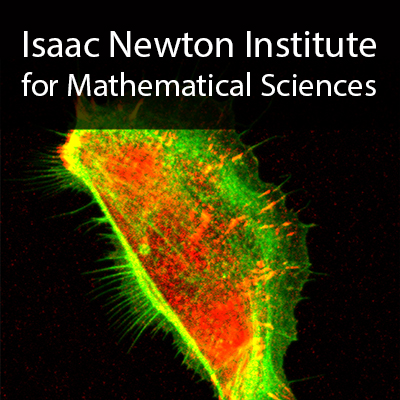Making Holes: Identifying How Metastatic Cancer Cells Apply Force to Invade Their Microenvironment
58 mins 49 secs,
342.77 MB,
WebM
640x360,
29.97 fps,
44100 Hz,
795.68 kbits/sec
Share this media item:
Embed this media item:
Embed this media item:
About this item

| Description: |
Weihs, D (Technion - Israel Institute of Technology)
Monday 7th December 2015 - 11:30 to 12:30 |
|---|
| Created: | 2015-12-21 09:46 |
|---|---|
| Collection: | Coupling Geometric PDEs with Physics for Cell Morphology, Motility and Pattern Formation |
| Publisher: | Isaac Newton Institute |
| Copyright: | Weihs, D |
| Language: | eng (English) |
| Abstract: | The process of invasion is of special importance in cancer metastasis, the main cause of death in cancer patients. Cells typically penetrate a matrix by degrading it or by squeezing through pores. However, cell mechanics and forces applied by cells especially during the initial stages of metastatic penetration, as metastatic cells indent a substrate, are still unknown. We measure the forces that cells apply to an impenetrable, synthetic 2-dimensional gel-matrix, effectively limiting cells to rely only on mechanical-interactions; gels are non-degradable polyacrylamide with sub-micron pores. We show that single metastatic breast-cancer cells will apply force to an impenetrable gel, and indent it in attempted invasion, when the gel is in the appropriate stiffness range; benign cells do not indent the gels. The metastatic cells require gel-substrates to be soft enough to indent, yet stiff enough to grip and generate force on. Cells develop grip handles and pull the underlying gel s inwards and upwards bringing the nucleus into the indentation concavity. We reveal a special coordinated role for the nucleus and the cytoskeleton when a single cell attempts to invade the impenetrable barrier. The actin, nucleus, and microtubules reorganize in sequence, with the actin at the leading edge of the cell. Cells repeatedly attempt penetration over several hours and then relocate, indicating an advanced mechano-transduction feedback loop. We use finite element analysis to identify force application patterns to maximize indentations, by varying cell size, shape and the locations and magnitudes of the mechanical loads applied by cells. We demonstrate that cells must combine lateral forces and significant normal forces to achieve the large, experimentally observed gel-indentations. The systems and analysis approaches shown here reveal cell adaptability and force application mechanisms.
Related Links http://www.weihs.net.technion.ac.il/ - Laboratory website |
|---|---|
Available Formats
| Format | Quality | Bitrate | Size | |||
|---|---|---|---|---|---|---|
| MPEG-4 Video | 640x360 | 1.93 Mbits/sec | 855.48 MB | View | Download | |
| WebM * | 640x360 | 795.68 kbits/sec | 342.77 MB | View | Download | |
| iPod Video | 480x270 | 521.88 kbits/sec | 224.76 MB | View | Download | |
| MP3 | 44100 Hz | 249.73 kbits/sec | 107.67 MB | Listen | Download | |
| Auto | (Allows browser to choose a format it supports) | |||||

